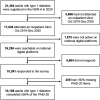Diabetes Distress and Associations With Demographic and Clinical Variables: A Nationwide Population-Based Registry Study of 10,186 Adults With Type 1 Diabetes in Norway
- PMID: 37922320
- PMCID: PMC10733651
- DOI: 10.2337/dc23-1001
Diabetes Distress and Associations With Demographic and Clinical Variables: A Nationwide Population-Based Registry Study of 10,186 Adults With Type 1 Diabetes in Norway
Abstract
Objective: To estimate diabetes distress prevalence and associations with demographic and clinical variables among adults with type 1 diabetes in Norway.
Research design and methods: In this nationwide population-based registry study, the 20-item Problem Areas in Diabetes (PAID-20) questionnaire was sent to 16,255 adults with type 1 diabetes. Linear regression models examined associations of demographic and clinical variables with distress.
Results: In total, 10,186 individuals (62.7%) completed the PAID-20, with a mean score of 25.4 (SD 18.4) and 21.7% reporting high distress. Respondents endorsed worrying about the future and complications as the most problematic item (23.0%). Female sex, younger age, non-European origin, primary education only, unemployment, smoking, continuous glucose monitoring use, more symptomatic hypoglycemia, reduced foot sensitivity, treated retinopathy, and higher HbA1c were associated with higher distress.
Conclusions: Diabetes distress is common among adults with type 1 diabetes and associated with clinically relevant factors, underlining that regular care should include efforts to identify and address distress.
© 2023 by the American Diabetes Association.
Conflict of interest statement
Figures



Comment in
-
Augen auf: Diabetes-Disstress ist häufig.MMW Fortschr Med. 2024 Nov;166(20):28. doi: 10.1007/s15006-024-4483-1. MMW Fortschr Med. 2024. PMID: 39576521 Review. German. No abstract available.
References
-
- Skinner TC, Joensen L, Parkin T.. Twenty-five years of diabetes distress research. Diabet Med 2020;37:393–400 - PubMed
-
- Fisher L, Polonsky WH, Hessler D.. Addressing diabetes distress in clinical care: a practical guide. Diabet Med 2019;36:803–812 - PubMed
-
- Holt RIG, DeVries JH, Hess-Fischl A, et al. . The management of type 1 diabetes in adults. A consensus report by the American Diabetes Association (ADA) and the European Association for the Study of Diabetes (EASD). Diabetes Care 2021;44:2589–2625 - PubMed
MeSH terms
Substances
Grants and funding
LinkOut - more resources
Full Text Sources
Medical

